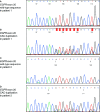Case Report: Afatinib Treatment in a Patient With NSCLC Harboring a Rare EGFR Exon 20 Mutation
- PMID: 33575211
- PMCID: PMC7871906
- DOI: 10.3389/fonc.2020.593852
Case Report: Afatinib Treatment in a Patient With NSCLC Harboring a Rare EGFR Exon 20 Mutation
Abstract
Unlike most other primary epidermal growth factor receptor (EGFR) mutations in non-small cell lung cancer (NSCLC), exon 20 insertions, comprising approximately 4% to 10% of all EGFR mutations, are generally considered to be resistant to EGFR tyrosine kinase inhibitors (TKIs). However, EGFR exon 20 insertions are structurally and pharmacologically heterogeneous, with variability in their position and size having implications for response to different EGFR TKIs. The second-generation ErbB family blocker, afatinib, is approved for the first-line treatment of EGFR mutation-positive NSCLC and has been shown to have a broad inhibitory profile against common and uncommon EGFR mutations. Here, we describe a patient with bilateral multifocal lung adenocarcinoma harboring a very rare EGFR exon 20 insertion (c.2317_2319dup3; p.H773dup), who has been receiving treatment with afatinib for 4.5 years. To our knowledge, this is the first report describing long-term benefit for a patient treated with afatinib with this rare exon 20 insertion. We are aware of two further cases with this rare EGFR mutation. One patient, also reported here, has early-stage lung adenocarcinoma and has not yet received systemic therapy for NSCLC. The other patient received afatinib in the context of a global compassionate use program and had progressive disease. Our findings may be of clinical relevance for patients carrying tumors with this rare mutation as epidemiological evidence suggests that p.H773dup may function as a driver mutation in NSCLC. Together with previous preclinical and clinical evidence for the activity of afatinib against certain EGFR exon 20 insertions, these findings warrant further investigation.
Keywords: EGFR mutation; H773dup; NSCLC; afatinib; exon 20 insertion; long-term response; uncommon mutation.
Copyright © 2021 Zöchbauer-Müller, Kaserer, Prosch, Cseh, Solca, Bauer and Müllauer.
Conflict of interest statement
SZM reports advisory council or committee relationship with Boehringer Ingelheim, Roche, MSD, BMS, Takeda, and AstraZeneca, honoraria from Bayer and Pfizer, and grants or funds from MSD. HP reports advisory council or committee relationship with Boehringer Ingelheim, Roche, MSD, and honoraria from Boehringer Ingelheim, Roche, MSD, BMS, and AstraZeneca. AC, FS, and MB report employment with Boehringer Ingelheim. LM reports consulting fees (advisory boards) from Boehringer Ingelheim. The authors declare that this case report received funding for medical writing assistance from Boehringer Ingelheim. The funder was involved in the conception and design, analysis and interpretation of data, knowledge generation from molecular data, the writing and reviewing of this article, the final approval, and the decision to submit it for publication. The remaining authors declare that the research was conducted in the absence of any commercial or financial relationships that could be construed as a potential conflict of interest.
Figures




Similar articles
-
Afatinib for the Treatment of NSCLC Harboring Uncommon EGFR Mutations: A Database of 693 Cases.J Thorac Oncol. 2020 May;15(5):803-815. doi: 10.1016/j.jtho.2019.12.126. Epub 2020 Jan 10. J Thorac Oncol. 2020. PMID: 31931137 Clinical Trial.
-
Afatinib in Non-Small Cell Lung Cancer Harboring Uncommon EGFR Mutations Pretreated With Reversible EGFR Inhibitors.Oncologist. 2015 Oct;20(10):1167-74. doi: 10.1634/theoncologist.2015-0073. Epub 2015 Sep 9. Oncologist. 2015. PMID: 26354527 Free PMC article.
-
Non-small cell lung cancer harbouring non-resistant uncommon EGFR mutations: Mutation patterns, effectiveness of epidermal growth factor receptor-tyrosine kinase inhibitors and prognostic factors.Eur J Cancer. 2019 Sep;119:77-86. doi: 10.1016/j.ejca.2019.06.025. Epub 2019 Aug 16. Eur J Cancer. 2019. PMID: 31425965
-
Heterogeneous Responses to Epidermal Growth Factor Receptor (EGFR) Tyrosine Kinase Inhibitors (TKIs) in Patients with Uncommon EGFR Mutations: New Insights and Future Perspectives in this Complex Clinical Scenario.Int J Mol Sci. 2019 Mar 21;20(6):1431. doi: 10.3390/ijms20061431. Int J Mol Sci. 2019. PMID: 30901844 Free PMC article. Review.
-
Afatinib for the treatment of EGFR mutation-positive NSCLC: A review of clinical findings.J Oncol Pharm Pract. 2020 Sep;26(6):1461-1474. doi: 10.1177/1078155220931926. Epub 2020 Jun 20. J Oncol Pharm Pract. 2020. PMID: 32567494 Free PMC article. Review.
Cited by
-
Molecularly Targeted Photothermal Ablation of Epidermal Growth Factor Receptor-Expressing Cancer Cells with a Polypyrrole-Iron Oxide-Afatinib Nanocomposite.Cancers (Basel). 2022 Oct 14;14(20):5043. doi: 10.3390/cancers14205043. Cancers (Basel). 2022. PMID: 36291827 Free PMC article.
-
Afatinib for the Treatment of NSCLC with Uncommon EGFR Mutations: A Narrative Review.Curr Oncol. 2023 May 28;30(6):5337-5349. doi: 10.3390/curroncol30060405. Curr Oncol. 2023. PMID: 37366888 Free PMC article. Review.
-
Case Report: Osimertinib Followed by Osimertinib Plus Bevacizumab, Personalized Treatment Strategy for a Lung Cancer Patient With a Novel EGFR Exon 20 Insertion D770_N771insGT and Multiple Brain Metastases.Front Oncol. 2021 Oct 25;11:733276. doi: 10.3389/fonc.2021.733276. eCollection 2021. Front Oncol. 2021. PMID: 34760695 Free PMC article.
-
Emerging therapies for non-small cell lung cancer harboring EGFR exon 20 insertion mutations: narrative review.Ann Transl Med. 2022 Dec;10(23):1283. doi: 10.21037/atm-2022-56. Ann Transl Med. 2022. PMID: 36618815 Free PMC article. Review.
-
Targeting EGFR Exon 20 Insertions in Non-Small Cell Lung Cancer: Recent Advances and Clinical Updates.Cancer Discov. 2021 Sep;11(9):2145-2157. doi: 10.1158/2159-8290.CD-21-0226. Epub 2021 Jul 23. Cancer Discov. 2021. PMID: 34301786 Free PMC article. Review.
References
Publication types
LinkOut - more resources
Full Text Sources
Other Literature Sources
Research Materials
Miscellaneous

